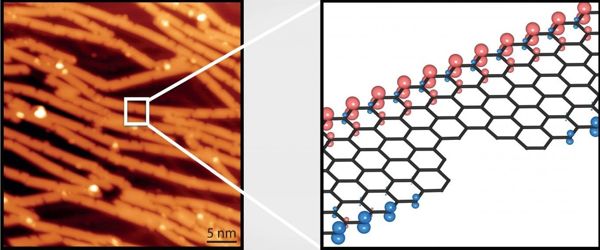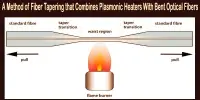A team of physicists and chemists created a highly sensitive sensor using a new heterostructure made of atomically precise graphene nanoribbons. A key enabling technology for the design of nanoscale electronic devices is the rational bottom-up synthesis of atomically defined graphene nanoribbon (GNR) heterojunctions. To date, synthetic approaches have relied on the random copolymerization of two electronically distinct molecular precursors to produce a segmented band structure within a GNR.
An international research team led by the University of Cologne has successfully connected several atomically precise nanoribbons made of graphene, a carbon modification, to form complex structures for the first time. Nanoribbon heterojunctions were synthesized and spectroscopically characterized by the researchers. The heterojunctions were then integrated into an electronic component. They have thus created a novel sensor that is highly sensitive to atoms and molecules.
A team of physicists and chemists has developed a highly sensitive sensor, which was made possible by a new heterostructure consisting of atomically precise graphene nanoribbons.
Their findings were published in Nature Communications under the title ‘Tunneling current modulation in atomically precise graphene nanoribbon heterojunctions.’ The work was done in collaboration with the Institute for Experimental Physics, the Department of Chemistry at the University of Cologne, and research groups from Montreal, Novosibirsk, Hiroshima, and Berkeley. The German Research Foundation (DFG) and the European Research Council (ERC) funded it (ERC).
The graphene nanoribbon heterojunctions are only one nanometre (one-millionth of a millimeter) wide. Graphene is the world’s thinnest material, consisting of only a single layer of carbon atoms. For the first time, researchers in Manchester succeeded in creating single-atom layers of graphene, for which they were awarded the Nobel Prize in 2010. ‘ The sensor’s graphene nanoribbon heterojunctions are seven to fourteen carbon atoms wide and about 50 nanometres long. What distinguishes them is that their edges are free of flaws.
This is why they are called “atomically precise” nanoribbons,’ explained Dr. Boris Senkovskiy from the Institute for Experimental Physics. The researchers connected several of these nanoribbon heterojunctions at their short ends, thus creating more complex heterostructures that act as tunneling barriers.

Angle-resolved photoemission, optical spectroscopy, and scanning tunnelling microscopy were used to investigate the heterostructures. The generated heterostructures were then integrated into an electronic device in the following step. The quantum mechanical tunnelling effect governs the electric current flowing through the nanoribbon heterostructure. This means that under certain conditions, electrons can overcome existing energy barriers in atoms by ‘tunnelling,’ allowing a current to flow even if the barrier is greater than the electron’s available energy.
The researchers created a novel sensor for atom and molecule adsorption from the nanoribbon heterostructure. The tunnel current passing through the heterostructure is especially sensitive to adsorbates that accumulate on the surface. That is, when atoms or molecules, such as those found in gases, accumulate on the sensor’s surface, the current strength changes. ‘The prototype sensor we built has outstanding properties. It is especially sensitive and can be used to measure even the smallest amounts of adsorbates,’ said Professor Dr. Alexander Grüneis, head of a research group at the Institute of Experimental Physics.
The work was done in collaboration with the Institute for Experimental Physics, the Department of Chemistry at the University of Cologne, and research groups from Montreal, Novosibirsk, Hiroshima, and Berkeley. The German Research Foundation (DFG) and the European Research Council (ERC) funded it (ERC).
















